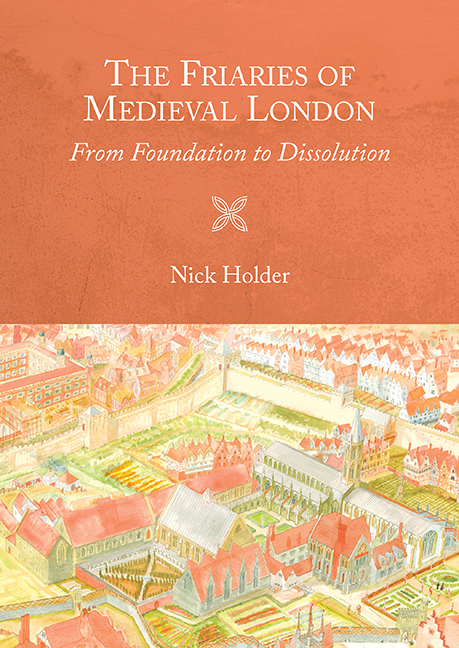Book contents
- Frontmatter
- Contents
- List of Illustrations and Tables
- Contributors
- Acknowledgements
- Abbreviations
- Introduction
- Part I The Nine London Friaries
- Part II The London Friars and their Friaries
- 10 Churches
- 11 Precincts and the Use of Space
- 12 Architecture and Architectural Fragments of the London Friaries
- 13 Floor Tiles and Building Materials from the London Friaries
- 14 Water Supply
- 15 Economy
- 16 Spiritual Life and Education in the London Friaries
- 17 Burial and Commemoration in the London Friaries
- 18 London Friars and Londoners
- 19 Dissolution
- Conclusions
- Timeline
- Bibliography
- Index
- Miscellaneous Endmatter
12 - Architecture and Architectural Fragments of the London Friaries
from Part II - The London Friars and their Friaries
Published online by Cambridge University Press: 16 May 2018
- Frontmatter
- Contents
- List of Illustrations and Tables
- Contributors
- Acknowledgements
- Abbreviations
- Introduction
- Part I The Nine London Friaries
- Part II The London Friars and their Friaries
- 10 Churches
- 11 Precincts and the Use of Space
- 12 Architecture and Architectural Fragments of the London Friaries
- 13 Floor Tiles and Building Materials from the London Friaries
- 14 Water Supply
- 15 Economy
- 16 Spiritual Life and Education in the London Friaries
- 17 Burial and Commemoration in the London Friaries
- 18 London Friars and Londoners
- 19 Dissolution
- Conclusions
- Timeline
- Bibliography
- Index
- Miscellaneous Endmatter
Summary
THE study of architectural fragments offers us the possibility of understanding – and even reconstructing – long-vanished medieval buildings. In a city such as London – where the Dissolution, the Great Fire, redevelopment and wartime bombing have taken a severe toll on the stock of medieval architecture – architectural fragments are the only surviving primary source for understanding the architectural styles and features of great lost medieval buildings, including the London friaries. More general discussion of the architecture of the friaries can be found in the friary-by-friary chapters of Part I of this book (Chapters 1 to 9), and in Chapter 10: Churches.
The architectural fragments have usually come to us through two processes: demolition and excavation. When masons were dismantling a medieval monastic building, for example in the fourteenth century in order to rebuild it or in the sixteenth century in order to destroy it, the more decorative pieces of stonework – windows, arches, door surrounds – were often recycled as rough foundation material: their particular shapes meant that they were not generally suitable for ‘ordinary’ recycling in new wall superstructures. Several centuries later, modern archaeologists encounter batches of this recycled ‘low value’ stonework in wall foundations. Sometimes this material is studied to great advantage; on other occasions the architectural fragments are retained but languish unstudied in museum store rooms.
About 140 architectural fragments from archaeological sites within the London friary precincts were identified at the Museum of London's archive and stores. The present author then examined this material to assess its potential to yield useful information about the architecture, structure and decoration of the friary buildings. It would be misleading to talk of a ‘statistically meaningful sample’ in what is essentially an art-historical exercise, but a sample of about thirty items (the majority of which are window fragments) has proved useful in answering the above points (Table 14). The tradition of art-historical and archaeological study of medieval architecture means that several important pieces of friary architecture that were discovered in the early twentieth century were preserved. A pillar and an arch from the undercroft of the late thirteenth-century chapter house at Black Friars survive, the former in the new Dominican priory in Belsize Park (London) and the latter in the wooded garden of the Selsdon Park Hotel in Croydon (London and Surrey).
- Type
- Chapter
- Information
- The Friaries of Medieval LondonFrom Foundation to Dissolution, pp. 211 - 226Publisher: Boydell & BrewerPrint publication year: 2017



